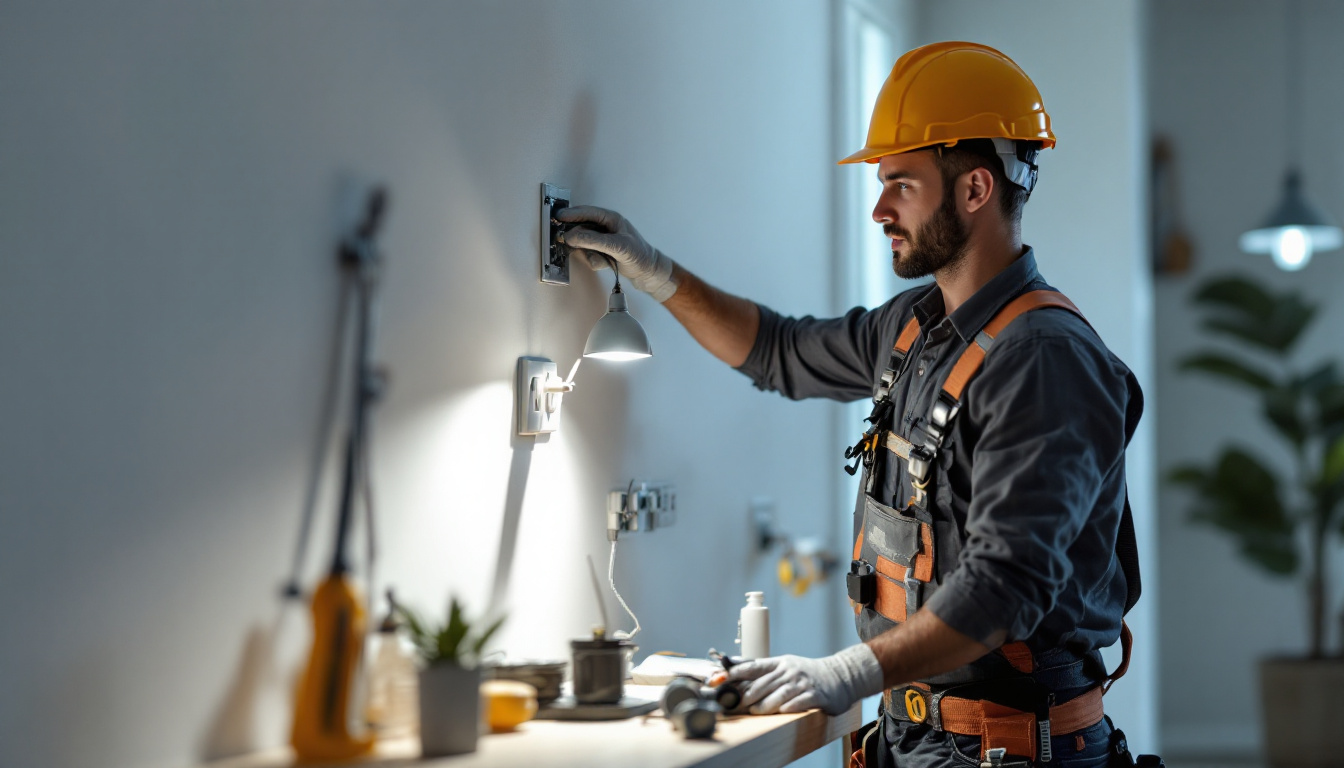
In the world of electrical installations, the outlet electrical box is a crucial component that often goes unnoticed. For lighting contractors, mastering the intricacies of these boxes can lead to enhanced efficiency, safety, and overall project quality. This article delves into the essential aspects of outlet electrical boxes, providing insights and best practices that can elevate the expertise of lighting contractors.
Outlet electrical boxes serve as the foundation for electrical connections in residential and commercial settings. They house electrical wiring and provide a safe enclosure for connections, ensuring compliance with electrical codes and standards. Understanding the different types of outlet boxes and their applications is vital for any lighting contractor.
There are several types of outlet electrical boxes, each designed for specific applications. The most common types include:
Choosing the right type of box is essential for ensuring safety and functionality in lighting installations. Each type has its own set of advantages and limitations, and understanding these can help contractors make informed decisions. For example, while plastic boxes are favored for their ease of installation, they may not provide the same level of protection against physical impacts as metal boxes, making the latter a better choice in high-traffic areas or industrial environments. Additionally, the choice of box can also affect the overall aesthetic of a space; for instance, metal boxes can be painted or finished to blend in with surrounding decor, while plastic boxes typically come in standard colors.
Electrical codes dictate the requirements for outlet electrical boxes, including their size, material, and installation methods. Familiarity with local and national codes is crucial for lighting contractors to ensure compliance and avoid costly penalties.
For instance, the National Electrical Code (NEC) outlines specific guidelines for box fill calculations, which determine how many wires and devices can safely fit within a box. Adhering to these guidelines not only ensures safety but also enhances the longevity of the installation. Furthermore, contractors must also consider the environmental factors that might affect the choice of box; for example, in areas prone to moisture, using weatherproof boxes is essential to prevent corrosion and electrical failures. Understanding the nuances of these codes and standards can significantly impact the quality and reliability of electrical installations, ultimately leading to safer and more efficient electrical systems.
proper installation of outlet electrical boxes is key to achieving a reliable and safe electrical system. Lighting contractors should follow best practices to ensure that installations are efficient and meet industry standards.
When installing outlet electrical boxes, placement and height are critical factors. Boxes should be installed at a height that is both accessible and convenient for end-users. Typically, the standard height for outlet boxes is 12 to 18 inches above the finished floor, but this can vary based on the specific application and local codes. For instance, in kitchens and bathrooms, outlets may need to be placed higher to accommodate countertops and cabinetry, while in living areas, the standard height often suffices.
Additionally, boxes should be positioned to avoid interference with other building elements, such as studs, plumbing, or HVAC systems. Proper planning during the installation phase can save time and reduce the risk of complications later on. It’s also wise to consider the flow of furniture and appliances in the space; ensuring that outlets are conveniently located can enhance the functionality of the room and reduce the need for unsightly extension cords. Furthermore, adhering to the National Electrical Code (NEC) guidelines can help ensure compliance and safety in your installations.
Securing the outlet electrical box is essential for maintaining stability and safety. Boxes should be anchored firmly to the wall or ceiling structure using appropriate fasteners. For metal boxes, grounding is also a critical consideration. Ensure that the box is properly grounded to minimize the risk of electrical shock. This grounding not only protects users but also helps to prevent interference with sensitive electronic devices, which can be particularly important in home offices or entertainment areas.
For added security, consider using box supports or brackets, especially in situations where the box will bear the weight of heavy fixtures or devices. This extra support can prevent sagging and ensure that the installation remains secure over time. Additionally, using non-conductive materials for mounting accessories can further enhance safety, particularly in damp environments. It’s also beneficial to periodically check the integrity of the installation, especially in high-traffic areas, to ensure that everything remains in optimal condition and that no wear and tear has compromised the electrical system’s safety. Regular maintenance can prolong the life of the installation and enhance overall safety for users.
Wiring techniques play a significant role in the performance and safety of outlet electrical boxes. Lighting contractors must be proficient in various wiring methods to ensure that installations are both efficient and compliant with regulations.
Selecting the appropriate wire gauge is crucial for preventing overheating and ensuring that the electrical system functions correctly. The wire gauge should be compatible with the load requirements of the lighting fixtures being installed.
For most residential lighting applications, 14-gauge wire is typically sufficient for circuits up to 15 amps, while 12-gauge wire is recommended for circuits up to 20 amps. Understanding the load requirements and selecting the right gauge can enhance the safety and efficiency of the installation.
Splicing wires within the outlet electrical box requires careful attention to detail. Proper splicing techniques ensure reliable connections and reduce the risk of electrical failures. Use wire nuts or connectors that are rated for the specific application, and ensure that all connections are secure and free from fraying.
Additionally, it is essential to follow best practices for wire management within the box. Keeping wires organized and avoiding overcrowding will facilitate easier troubleshooting and maintenance in the future.
Lighting contractors often encounter various challenges when working with outlet electrical boxes. Identifying these challenges and understanding how to address them can significantly improve project outcomes.
In many installations, space constraints can pose significant challenges for outlet box placement and wiring. In such cases, consider using compact or shallow boxes designed for tight spaces. These boxes can provide the necessary functionality without compromising safety.
Additionally, utilizing flexible conduit or cable can help navigate around obstacles and tight corners, allowing for a more streamlined installation process.
Encountering code violations during an installation can be frustrating. However, identifying and addressing these issues promptly is essential for ensuring compliance and safety. When a violation is discovered, consult local codes and regulations to determine the necessary corrective actions.
In some cases, it may be necessary to adjust the installation, replace components, or even rewire sections of the circuit. Proactive communication with clients about potential code issues can also help manage expectations and maintain trust.
As lighting contractors gain experience, they may wish to explore advanced techniques that can further enhance their expertise in working with outlet electrical boxes. These techniques can lead to more efficient installations and improved client satisfaction.
With the rise of smart home technology, integrating smart lighting systems into outlet electrical boxes has become increasingly popular. This involves installing smart switches or outlets that allow for remote control and automation of lighting systems.
When integrating smart technology, it is essential to ensure that the outlet box can accommodate the additional wiring and devices. Planning for smart home integration during the initial installation phase can save time and reduce complications later on.
Energy efficiency is a growing concern for many clients, and lighting contractors can play a pivotal role in promoting energy-saving solutions. When installing outlet electrical boxes, consider incorporating energy-efficient lighting options, such as LED fixtures.
Additionally, educating clients about the benefits of energy-efficient systems can lead to more informed decisions and increased satisfaction. Providing options for dimmers or timers can also enhance energy efficiency and contribute to a more sustainable installation.
Mastering the intricacies of outlet electrical boxes is essential for lighting contractors seeking to enhance their skills and deliver high-quality installations. By understanding the various types of boxes, adhering to safety standards, and employing best practices during installation, contractors can improve their efficiency and client satisfaction.
As the industry continues to evolve, embracing advanced techniques such as smart home integration and energy efficiency considerations will further elevate the expertise of lighting contractors. By staying informed and adapting to new technologies, contractors can ensure that they remain competitive in a rapidly changing market.
Ultimately, the mastery of outlet electrical boxes is not just about technical proficiency; it is also about delivering value to clients and ensuring the safety and functionality of electrical installations. With the right knowledge and skills, lighting contractors can excel in their field and contribute to the advancement of the electrical industry.
Ready to take your lighting installations to the next level? LumenWholesale is here to support your mastery of outlet electrical boxes with our extensive selection of top-quality, spec-grade lighting products. Enjoy unbeatable wholesale prices and the convenience of cutting out the middleman, ensuring you get the most value for your investment. With free shipping on bulk orders, you can stock up on reliable, high-performance lighting without worrying about hidden fees. Elevate your projects with the perfect blend of quality, affordability, and convenience. Wholesale Lighting at the Best Value is just a click away.

Discover the essential role of ballasts in lighting systems with insights from top contractors.

Explore the pivotal role of Universal Lighting Technologies in modern lighting installations.

Discover why lighting contractors should prioritize sidewalk solar lights in their projects.

Discover the essentials of solar pathway lights in just five minutes! This quick guide for lighting contractors covers installation tips, energy efficiency benefits, and the latest innovations to illuminate your projects sustainably and effectively..